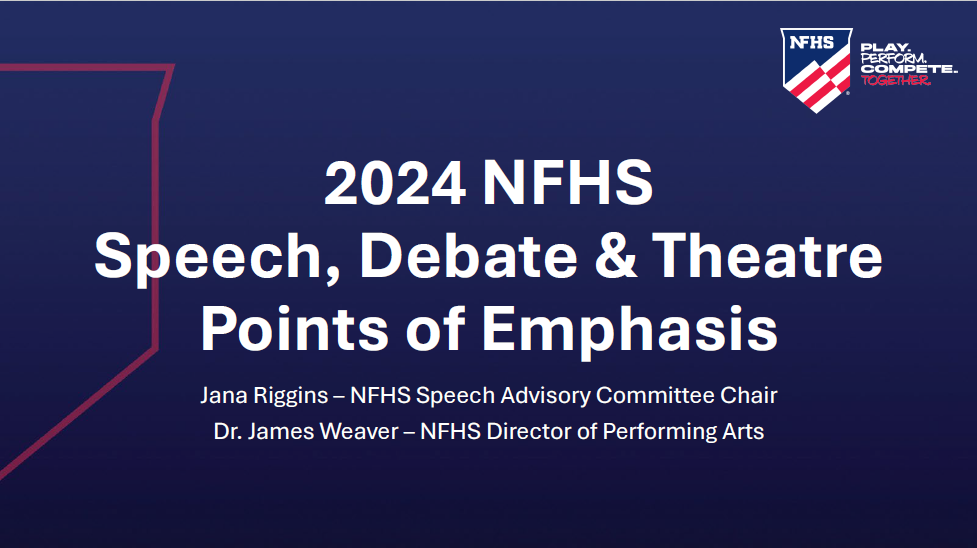| Click below to download PowerPoint versions of the 2024 Music Committee Points of Emphasis for your use in presentations. |
| Version 1 (colorful) |
| Version 2 (blue) |
| Version 3 (white) |
Injury Surveillance
The NFHS recognizes that injuries may occur in performing arts activities. Marching band and show choir have come into the spotlight due to the physical rigors of these activities. Foot, ankle, knee, hip, back and concussion injuries are occurring, and it is imperative for schools to have a resource to report and track such injuries nationwide, providing data to help assist in best practices. Schools are encouraged to participate in the High School RIO™ program, and financial incentives are available for participating schools’ Certified Athletic Trainers.
High School RIO™ is an internet-based data collection tool used in the National High School Sports-Related Injury Surveillance Study. High School RIO™ has evolved over time to best fulfill the needs of student-athletes, parents, pediatric sports medicine clinicians, school administrators, state associations and the NFHS.
Workforce Development
Plans to recruit and retain the next generation of music educators are imperative to sustain school-based music and arts. Performing arts activities in schools provide the opportunity for students to turn the skills and abilities learned into a lifelong career. State associations in conjunction with member schools, have a vehicle to promote pursuing these opportunities with a wide variety of resources in arts advocacy. The NFHS has partnered with arts organizations to help bridge the gap for students interested in pursuing careers in music and arts. Resources are available at www.artsadvocacy.nfhs.org/careers .
Hearing Loss/ Repetitive Strain Injuries
Recognizing that there are inherent risks involved in music, the NFHS believes that a heightened state of awareness is needed to prevent long-term injuries to both students and educators.
Students and educators are at risk of developing permanent hearing loss and other hearing disorders because of repeated exposure to high decibel levels. Music educators should examine the risks associated with high decibel exposure and enact processes to protect hearing.
Students and educators should understand how to avoid injuries sustained by overuse and repetitive motion. Specific to instrumental music, injuries include hand and wrist damage, jaw discomfort, nerve compression, ligament injuries, back injuries and tendinitis. Anyone experiencing pain while participating in music should take steps to avoid potential injury.
Equity/Access
The NFHS believes that all students should have equitable access to performing arts opportunities. Educators should provide equal access to resources, supplies, instruments, attire, etc. and provide reasonable accommodations for those who lack access. Educators and adjudicators should not penalize students based on their access to these resources. The focus of the performing arts competition should be the excellence of the student content.
Outdoor Environmental Factors
1. Air Quality
The Air Quality Index (AQI) is a system developed by the US Environmental Protection Agency that describes the general health effects associated with different pollution levels. Precautionary steps may be needed if air pollution levels rise to an unhealthy state. During times of suspected high air pollution, the AQI should be checked by a designated person prior to and throughout all practices, performances and contests.
A particular location's AQI can be found at https://www.airnow.gov/. As specific public health department recommendations may vary, it is critical that state associations and schools consult local or state health departments for guidelines on when outdoor activities should be modified or canceled.
2. Heat Illness Prevention
Students participating in high-intensity, long-duration or repeated same-day practices and training activities during hot-weather days are at risk for heat illness. Following the recommended guidelines in the “NFHS Heat Illness Prevention” position statement can reduce the risk of serious illness during activities. States should incorporate all heat illness prevention fundamentals with emphasis on acclimatization, hydration, immediate first aid, and emergency action plans in suspected heat illness situations. Schools are encouraged to utilize a Wet Bulb Globe Temperature device to monitor days with substantial risk. This WBGT/Video is a resource from the NFHS showing how-to information for your Kestrel 5400 Heat Stress Tracker. The online NFHS courses Heat Illness Prevention and/or Marching Band Safety are strongly recommended for all educators and staff.
NFHS
Most Recent Articles
- 2025 Performing Arts Education and Creative Industry Meeting Materials
- Boys Lacrosse Season Preview - 2025
- Girls Lacrosse Season Preview - 2025
- nfhs news Risk Minimization Focus of 2025-26 High School Spirit Rules Changes
- nfhs news Supporting High Schools, State Associations to Determine Eligibility, Transfer Rules





